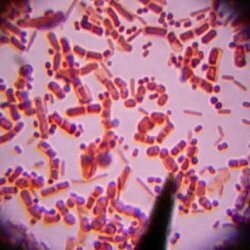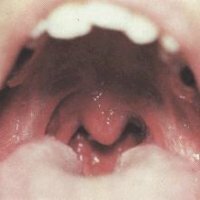Meningococcal infections
 Meningococcus, also a diplococcus of Neisseria meningitidis, causes such dangerous to human diseases as meningitis and( or) meningococcal sepsis, bacteremia and inapharyngitis. In view of the fact that meningococcus belongs to highly contagious infections, the greatest threat to a person is bacterial purulent meningitis and meningococcemia, often resulting in a fatal outcome.
Meningococcus, also a diplococcus of Neisseria meningitidis, causes such dangerous to human diseases as meningitis and( or) meningococcal sepsis, bacteremia and inapharyngitis. In view of the fact that meningococcus belongs to highly contagious infections, the greatest threat to a person is bacterial purulent meningitis and meningococcemia, often resulting in a fatal outcome.
Epidemiology
Meningokkok is anthroponosis, that is, infection occurs exclusively from person to person. In everyday life, the virus of meningococcal infection colonizes the mucous membrane of the human nasopharynx, circulating among the population of people. The mechanism of infection is air-aerosol, transmission of infection occurs when coughing, talking, screaming, sneezing. Everyone can get infected, due to the high susceptibility to the pathogen and the asymptomatic course of the disease in the carrier. There is a cyclicality of outbreaks of this infection with changes that occur on average every 10 years, characterized by an increase in the incidence rate. The study of the properties of meningococci can reveal the prevalence of infection, the effect on the incidence of seasonal factors. The peak of outbreaks is winter and early spring. The risk groups among the age groups are as follows: the children of the first year of life are more susceptible to infection, the lowest in the age group over 30.Particular attention deserves the emergence of foci of infection with generalized forms in pre-school and school children's groups, indoor facilities, among the military. People who have undergone a meningococcal infection develop sufficiently resistant immunity to certain serotypes of meningococcus.
Symptoms of the disease with meningococcal infection
The incubation period of the disease is on average 2-3 days. Relatively safe forms of the disease for humans are primarily localized in the form of bacteriocarriers and nasopharyngitis. The latter form is most common and proceeds as a cold disease with typical symptoms in the form of weakness, headache, difficulty swallowing, dry cough, nasal congestion with insignificant secretion. Body temperature is low, children are observed to increase to 38-39 ° C.
Usually the disease ends with complete recovery. However, complications in the form of meningococcal pneumonia, inflammation of the heart muscle, joint damage, mucous eyes are possible.
The main clinical forms of meningococcal infection, requiring immediate hospitalization and inpatient treatment, are associated with the defeat of the brain envelopes and the development of meningococcemia.
Meningococcal meningitis
Symptoms
meningitis In the initial stages of the disease there is severe headache, confusion, up to a total loss, develop convulsions, manifested symptoms of focal neurological deficit in the form of paresis of the limbs and cranial nerve, cerebellar disorders, often the disease is accompanied by mental disorders.
Clinical symptoms in patients with acute bacterial meningitis.
Rigidity( tension) of the occipital muscles of the neck - when trying to bend the patient's head forward there is a strain of the posterior cervical muscles. In this case, the patient himself can not get his chin to his chest. The patient develops a characteristic pose of a "dog" - an upturned head, legs bent at the knees, pulled to the stomach. When trying to change the position of the patient's head, a sharp painful response occurs. Kernig Symptom - a patient lying on his back, bend a relaxed leg at a right angle in the hip and knee joints, and then try to fully unbend it in the knee joint. Pain resulting from irritation of nerve roots, prevents the extension of the limb.
Symptoms of the disease depending on the form of the infection can be expressed or isolated, and also be accompanied by other symptoms. Although the foregoing symptoms are observed in half of adult patients with a diagnosis of meningitis, their absence does not exclude the diagnosis of meningococcal infection.
Other manifestations of meningococcal meningitis should be noted, including localized symptoms of brain damage and cranial nerves similar to the development of subarachnoid hemorrhage or subarachnoid stroke. It is important that in patients with meningitis, the symptoms of the disease may not be typical. Therefore, in a patient with altered mental status and elevated body temperature, the diagnosis of bacterial meningitis can not be rejected until the results of a spinal fluid test are obtained in order to exclude hemorrhagic stroke or other forms of bacterial meningitis caused by other bacterial agents such as tuberculosis, viruses, pneumococcus.
Generalized forms of meningococcal infection
Meningococcal meningitis often occurs with a generalized form of meningococcal infection called meningococcemia. Symptoms of the onset of the disease - the temperature rises sharply, there is a chill, a constant severe headache, possible vomiting, photophobia, aching pain in the muscles and joints. The most characteristic symptom of the manifestation of the disease is a skin rash with elements of hemorrhage( hemorrhage), appearing several hours after the disease, sometimes on the second day of the disease. The elements of the rash can have a characteristic irregular stellate shape from red to cyanotic color, ranging in size from small to large elements, a few centimeters in diameter. Rashes visually and touchingly rises above the surface of the skin. Spread and localization of the rash in the lower and upper extremities, buttocks, lateral surface of the trunk, back area.
When the disease is manifested, the spread of the geography of the rash with its localization throughout the body and the increase in the size of the eruptions of the hemorrhagic nature is noted. In the phase of resolution, necrosis( tissue necrosis) is formed on the sites and sites of massive hemorrhages, like dry gangrene with localization in the nose, ear shells, terminal phalanges of fingers and feet. Often there are hemorrhages in the mucous membranes of the mouth and conjunctiva of the eyes. A severe complication of the course of meningococcemia is hemorrhage in the adrenal glands with the development of an infectious-toxic shock, as well as the development of a hemorrhagic syndrome with massive external and internal bleeding.
Unreasonable and non-rational use of antibacterial drugs led to an increase in the number of atypical smoothened forms of meningitis and, as a consequence, paradoxically, lightning-fast forms of meningococcal infection often began to occur. The combination of meningococcemia with meningitis is the worst form of the course of meningococcal infection in terms of risks and prognosis. In this case, hemorrhages in the form of a rash, as a rule, appears several hours earlier than the envelopes of the brain are affected.
The final diagnosis is made after a complete laboratory and bacteriological study of materials such as mucus from the nose and throat, liquor and blood. In the first hours of the examination, when hospitalization was in the hospital, the analysis of cerebrospinal fluid with bacterioscopy, with immediate blood collection, swabs from the throat and nose, for carrying out special immunological studies and further bacteriological analysis of cerebrospinal fluid and blood, with subsequent isolation, indication andTyping of the causative agent of meningococcal infection.



